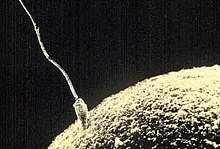
Back تكاثر إغراسي Arabic Аагамія Byelorussian Oogamija BS Oogamie Czech Oogamie German Oogamia Spanish Oogamia Finnish Oogamie French Oogámia Hungarian Oogami ID

Oogamy is a form of anisogamy where the gametes differ in both size and form. In oogamy the large female gamete (also known as ovum) is immotile, while the small male gamete (also known as sperm) is mobile.[1] Oogamy is a common form of anisogamy, with almost all animals and land plants being oogamous.
Oogamy is found in most sexually reproducing species, including all vertebrates, land plants, and some algae. The ancestral state of sexual reproduction is believed to be isogamy, with oogamy evolving through anisogamy. Once oogamy evolves, males and females typically differ in various aspects. Internal fertilization may have originated from oogamy, although some studies suggest [2] that oogamy in certain species may have evolved before the transition from external to internal fertilization. In streptophytes, oogamy occurred before the split from green algae.
- ^ Fusco, Giuseppe; Minelli, Alessandro (2019-10-10). The Biology of Reproduction. Cambridge University Press. pp. 111–112. ISBN 978-1-108-49985-9. Retrieved 29 March 2021.
- ^ Nozaki, H., Yamada, T. K., Takahashi, F., Matsuzaki, R., & Nakada, T. (2014). New "missing link" genus of the colonial volvocine green algae gives insights into the evolution of oogamy. BMC evolutionary biology, 14(1), 37. https://doi.org/10.1186/1471-2148-14-37
© MMXXIII Rich X Search. We shall prevail. All rights reserved. Rich X Search